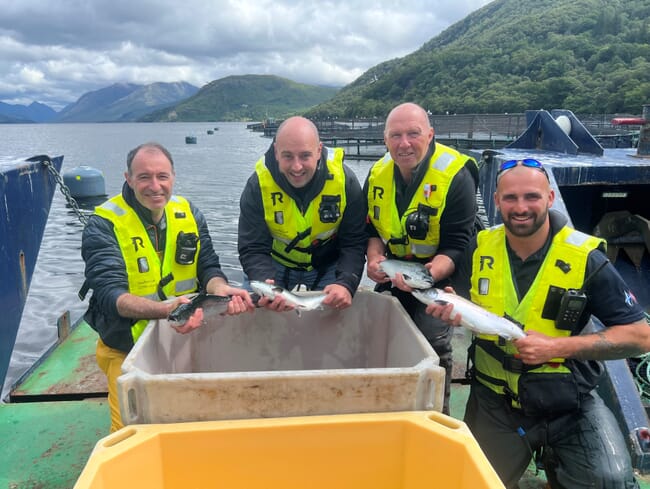
© Mowi Scotland
The sea lice model, developed by Dr Philip Gillibrand, Mowi's head of oceanography and environmental monitoring, aims to enhance the management of sea lice in salmon farms. Dr Gillibrand's model is particularly complex, comparing the continuous production of sea-grown rainbow trout with a new strategy involving the production of salmon smolts in two annual cycles, incorporating fallow periods. Initial predictions suggest that this strategy could significantly reduce sea lice levels.
In mid-July, Dr Gillibrand, alongside Ben Hadfield, COO of Mowi Farming Scotland, Ireland, Faroes, and Atlantic Canada, conducted a site visit to Loch Etive to assess the model's performance against actual sea lice levels. Early results indicate that while the model shows promise, it has initially overestimated sea lice populations, a common outcome in environmental modelling. "The model includes a degree of precaution, and the lice count data we are collecting will help fine-tune the predictions," Dr Gillibrand noted.
Dr Gillibrand's work on sea lice models spans over six years and involves collaboration with the Scottish Environment Protection Agency (SEPA), Marine Scotland, and other scientific institutions to ensure a rigorous and transparent model. Despite the challenges inherent in environmental modelling, which often involve balancing accuracy with precaution, the results at Loch Etive have shown that this approach can be effective.
Ben Hadfield expressed optimism regarding the early findings, noting that the post-smolt salmon are in excellent condition, with low sea lice levels. He acknowledged, however, that the model's overestimation of lice levels was due to the cautious assumptions built into the environmental model—a necessary approach given the current regulatory landscape.
The role of sea lice modelling in Scottish aquaculture regulation
The introduction of sea lice modelling is becoming increasingly significant in the regulation of Scottish salmon farming, particularly following SEPA's implementation of the Sea Lice Risk Framework (SLRF). This framework models the migration of wild salmon through farming regions on Scotland's West Coast and was initially proposed by the salmon industry as a method of improving the relationship between the sector and wild fish conservation efforts.
Hadfield emphasised the importance of having a robust and validated model to predict sea lice levels, noting that it could take several years to develop an accurate and reliable system, even with the resources committed by Mowi Scotland.
Future of post-smolt salmon farming at Loch Etive
In late 2023, Mowi Scotland was granted permission to begin post-smolt salmon production at Loch Etive, with the first fish introduced to the site in late 2023. The fish raised at Loch Etive will be used to stock Mowi’s larger operations in the Small Isles, Loch Linnhe, and Loch Seaforth.
Mowi Scotland has expressed confidence in the sustainability of its Loch Etive operation, which it views as a viable alternative to more resource-intensive land-based post-smolt production. The company believes that its new approach, which includes synchronised fallowing periods across the loch, will help maintain low sea lice levels due to the brackish nature of the water, which is less conducive to sea lice proliferation.
This innovative farming strategy is also expected to reduce environmental impacts by lowering feed usage and organic waste production, ultimately minimising the carbon footprint on the seabed.
